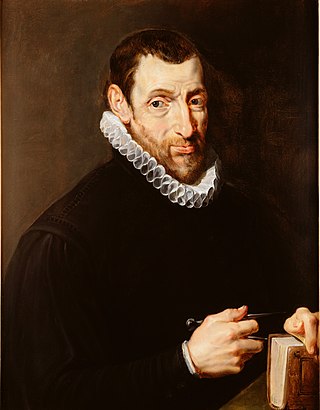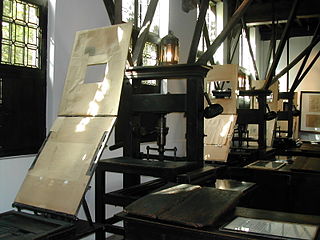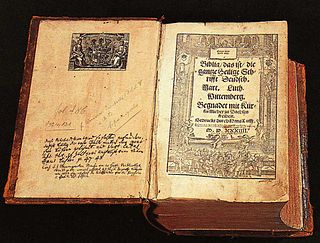
The Plantin Polyglot (also called the Antwerp Polyglot, the Biblia Regia or "King's Bible") is a polyglot Bible, printed under the title Biblia Polyglotta by Christopher Plantin in Antwerp (Belgium) between 1568 and 1573.

The Plantin Polyglot (also called the Antwerp Polyglot, the Biblia Regia or "King's Bible") is a polyglot Bible, printed under the title Biblia Polyglotta by Christopher Plantin in Antwerp (Belgium) between 1568 and 1573.
Plantin was suspected of Calvinist sympathies, although Antwerp at that time was firmly Catholic. He developed a plan to prove his loyalty to the Catholic king Philip II of Spain by producing a polyglot version of the Bible, in five languages. The king promised to finance the project — completing it nearly bankrupted Plantin — and sent the Spanish theologian Benito Arias Montano to Antwerp to watch over the production of this eight-volume of printing, which was printed in 1,200 copies on paper and 12 copies on parchment. Printing the Bible required thirteen printing presses and fifty-five men to run them, as well as expert linguists who acted as proofreaders. [1]
The first four volumes contain the Old Testament. The left page has two columns with the Hebrew original and the Latin translation, the right page has same text in Greek with its own Latin translation. Underneath these columns there is an Aramaic version on the left-hand page and a Latin translation of this on the right-hand side. For printing the Hebrew text Plantin used among others Daniel Bomberg's Hebrew type, which he had received from Bomberg's nephews. [2] Volume 5 contains the New Testament in Greek and Syriac, each with a Latin translation, and a translation of the Syriac into Hebrew. Volume 6 has the complete Bible in the original Hebrew and Greek, as well as an interlinear version that has the Latin translation printed between the lines. The last two volumes contain dictionaries (Hebrew-Latin, Greek-Latin, Syriac-Aramaic, grammar rules, list of names, etc.) that were of value to scholars. A complete copy of this Bible is on display at the Plantin-Moretus Museum (the site of the original printing press), including the typefaces used on the project.

The Septuagint, sometimes referred to as the Greek Old Testament or The Translation of the Seventy, and often abbreviated as LXX, is the earliest extant Greek translation of the Hebrew Bible from the original Hebrew. The full Greek title derives from the story recorded in the Letter of Aristeas to Philocrates that "the laws of the Jews" were translated into the Greek language at the request of Ptolemy II Philadelphus by seventy-two Hebrew translators—six from each of the Twelve Tribes of Israel.

The Masoretic Text is the authoritative Hebrew and Aramaic text of the 24 books of the Hebrew Bible (Tanakh) in Rabbinic Judaism. The Masoretic Text defines the Jewish canon and its precise letter-text, with its vocalization and accentuation known as the mas'sora. Referring to the Masoretic Text, masorah specifically means the diacritic markings of the text of the Jewish scriptures and the concise marginal notes in manuscripts of the Tanakh which note textual details, usually about the precise spelling of words. It was primarily copied, edited, and distributed by a group of Jews known as the Masoretes between the 7th and 10th centuries of the Common Era (CE). The oldest known complete copy, the Leningrad Codex, dates from the early 11th century CE.

The Bible has been translated into many languages from the biblical languages of Hebrew, Aramaic, and Greek. As of September 2023 all of the Bible has been translated into 736 languages, the New Testament has been translated into an additional 1,658 languages, and smaller portions of the Bible have been translated into 1,264 other languages according to Wycliffe Global Alliance. Thus, at least some portions of the Bible have been translated into 3,658 languages.

The Peshitta is the standard version of the Bible for churches in the Syriac tradition, including the Maronite Church, the Chaldean Catholic Church, the Syriac Catholic Church, the Syriac Orthodox Church, the Malankara Orthodox Syrian Church, the Malabar Independent Syrian Church, the Syro-Malankara Catholic Church, the Assyrian Church of the East and the Syro-Malabar Church.

Christophe Plantin was a French Renaissance humanist and book printer and publisher who resided and worked in Antwerp. He established in Antwerp one of the most prominent publishing houses of his time, the Plantin Press. It played a significant role in making Antwerp a leading centre of book publishing in Europe. The publishing house was continued by his successors until 1867.

The Plantin Press at Antwerp was one of the focal centers of the fine printed book in the 16th century.

The Complutensian Polyglot Bible is the name given to the first printed polyglot of the entire Bible. The edition was initiated and financed by Cardinal Francisco Jiménez de Cisneros (1436–1517) and published by Complutense University in Alcalá de Henares, Spain. It includes the first printed editions of the Greek New Testament, the complete Septuagint, and the Targum Onkelos. Of the 600 six-volume sets which were printed, only 123 are known to have survived to date.

A polyglot is a book that contains side-by-side versions of the same text in several different languages. Some editions of the Bible or its parts are polyglots, in which the Hebrew and Greek originals are exhibited along with historical translations. Polyglots are useful for studying the history of the text and its interpretation.

The Plantin–Moretus Museum is a printing museum in Antwerp, Belgium which focuses on the work of the 16th-century printers Christophe Plantin and Jan Moretus. It is located in their former residence and printing establishment, the Plantin Press, at the Vrijdagmarkt in Antwerp, and has been a UNESCO World Heritage Site since 2005.

Frans van Ravelingen Latinized Franciscus Raphelengius, was a Flemish-born scholar, printer and publisher, working in Antwerp and later in Leiden. During the last decade of his life he was professor of Hebrew at Leiden University. He produced an Arabic-Latin dictionary, of about 550 pages, which was published posthumously in 1613 in Leiden. This was the first publication by printing press of a book-length dictionary for the Arabic language in Latin.
Several Spanish translations of the Bible have been made since approximately 700 years ago.
Jewish printers were quick to take advantages of the printing press in publishing the Hebrew Bible. While for synagogue services written scrolls were used, the printing press was very soon called into service to provide copies of the Hebrew Bible for private use. All the editions published before the Complutensian Polyglot were edited by Jews; but afterwards, and because of the increased interest excited in the Bible by the Reformation, the work was taken up by Christian scholars and printers; and the editions published by Jews after this time were largely influenced by these Christian publications. It is not possible in the present article to enumerate all the editions, whole or partial, of the Hebrew text. This account is devoted mainly to the incunabula.
Guy Lefèvre de la Boderie was a French Orientalist, Bible scholar and poet.
Arabic translations of the Bible constitute one of the richest traditions of Bible transmission. Translations of the Bible into Arabic were produced by Arabic-speaking Jews, Christians, and Samaritans. Even though Arabic was spoken by Jews and Christians before the advent of Islam, running Arabic translations of the Bible are attested in manuscripts only from the 9th century CE onwards. So far, no evidence could be adduced that Arabic Bible translations were available at that time. Before that, quotations from the Bible were used in Arabic especially by Christians.

A Protestant Bible is a Christian Bible whose translation or revision was produced by Protestant Christians. Typically translated into a vernacular language, such Bibles comprise 39 books of the Old Testament and 27 books of the New Testament, for a total of 66 books. Some Protestants use Bibles which also include 14 additional books in a section known as the Apocrypha bringing the total to 80 books. This is in contrast with the 73 books of the Catholic Bible, which includes seven deuterocanonical books as a part of the Old Testament. The division between protocanonical and deuterocanonical books is not accepted by all Protestants who simply view books as being canonical or not and therefore classify books found in the Deuterocanon, along with other books, as part of the Apocrypha. Sometimes the term "Protestant Bible" is simply used as a shorthand for a bible which contains only the 66 books of the Old and New Testaments.
Samuel Bagster the elder was the founder of the publishing firm of Bagster & Sons.

Elias Hutter was a German Hebraist.

The Bible translations into Latin date back to classical antiquity.

Martina Plantin (1550–1616) was involved in her father's printing business from five years of age, and ran the family lace shop from the age of 17. After her father and husband had died, she was the head of the Plantin-Moretus printing business from 1610 to 1614, with daily operations managed by her sons Balthasar and Jan. She was considered a "formidable businesswoman from the wealthy bourgeoisie" and the head of the Plantin-Moretus printing dynasty, by marrying Jan Moretus and being the daughter of publisher Christophe Plantin.